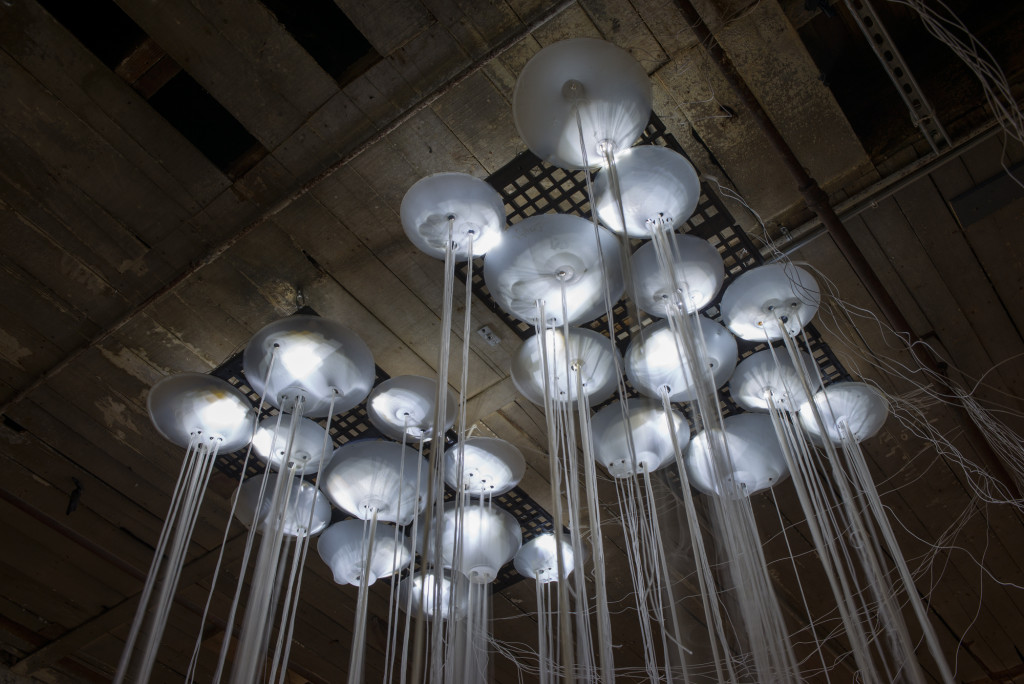
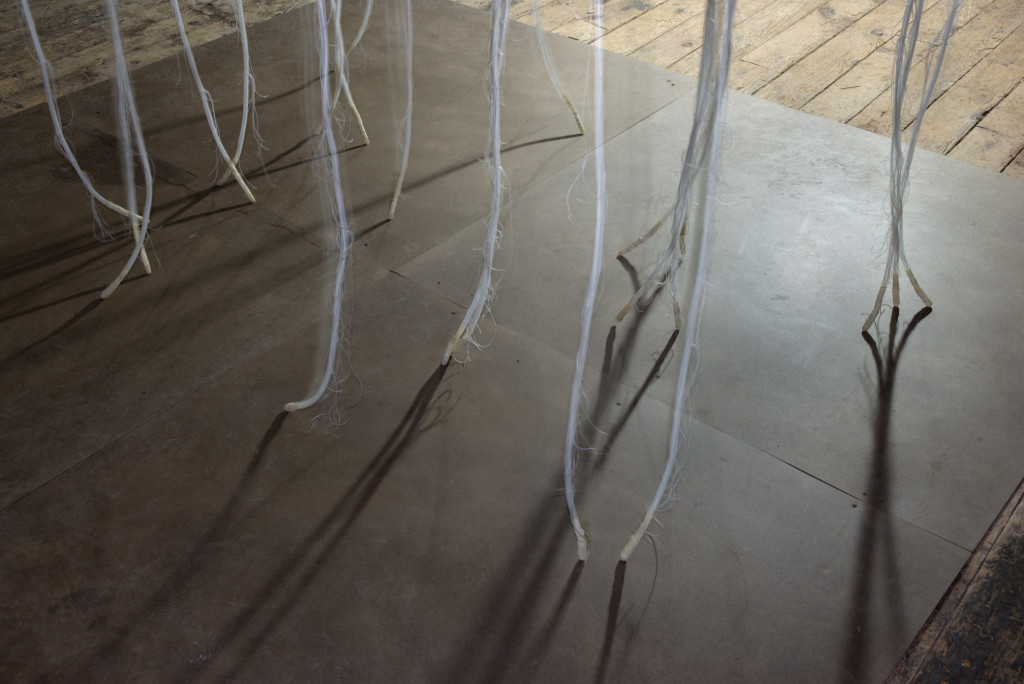
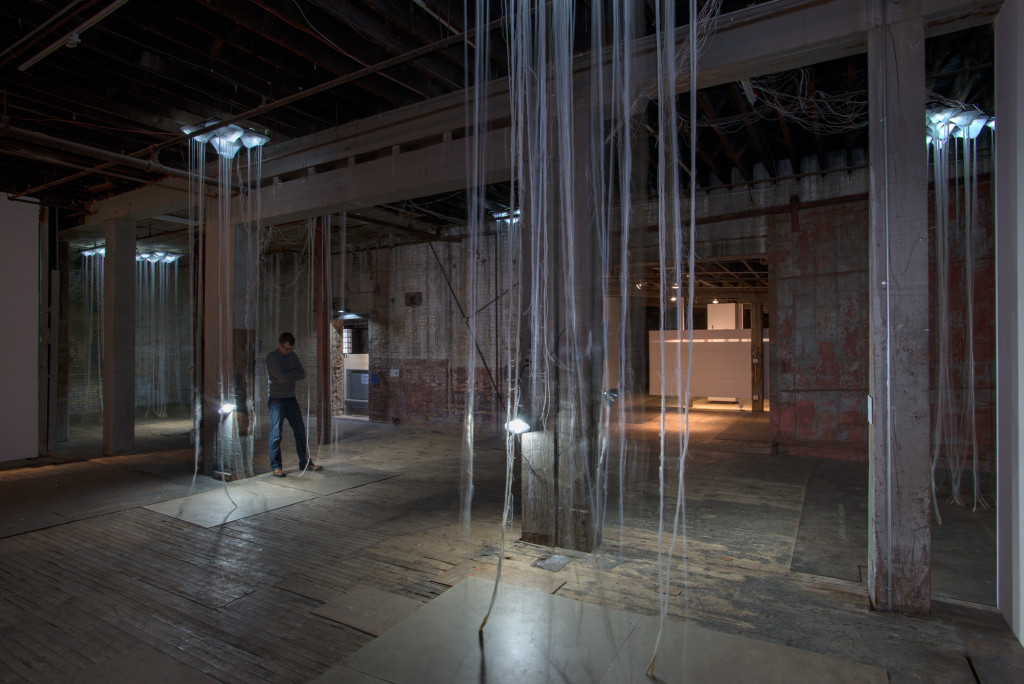
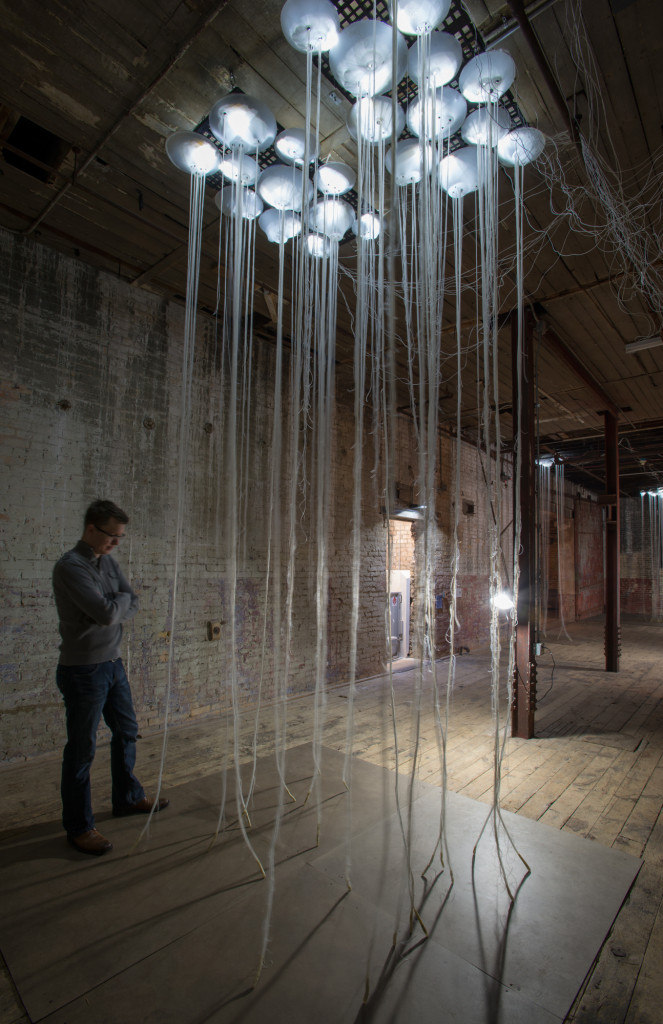
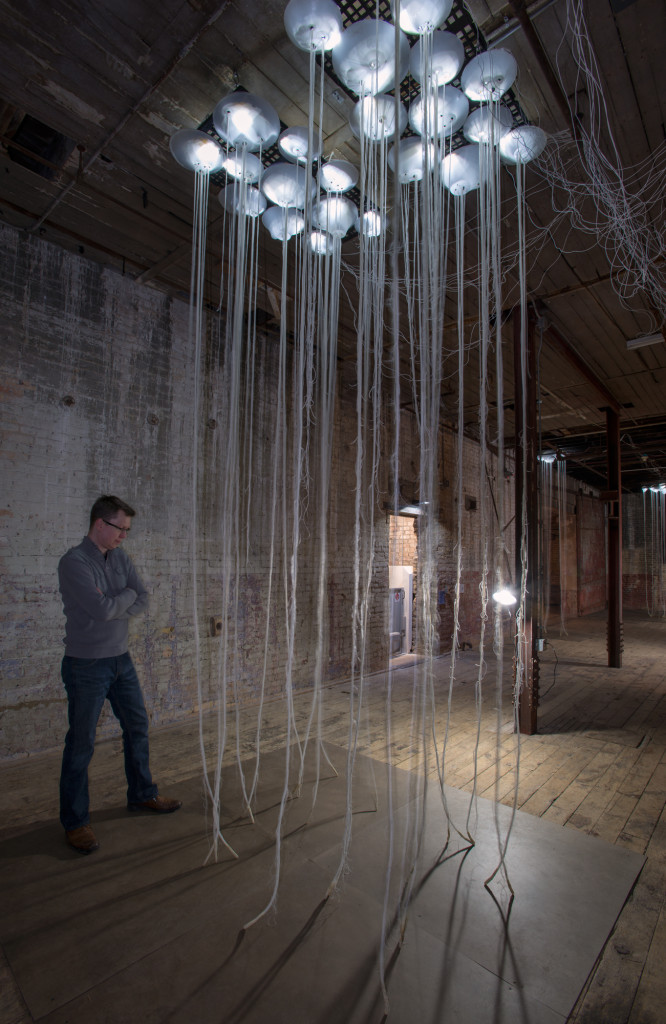
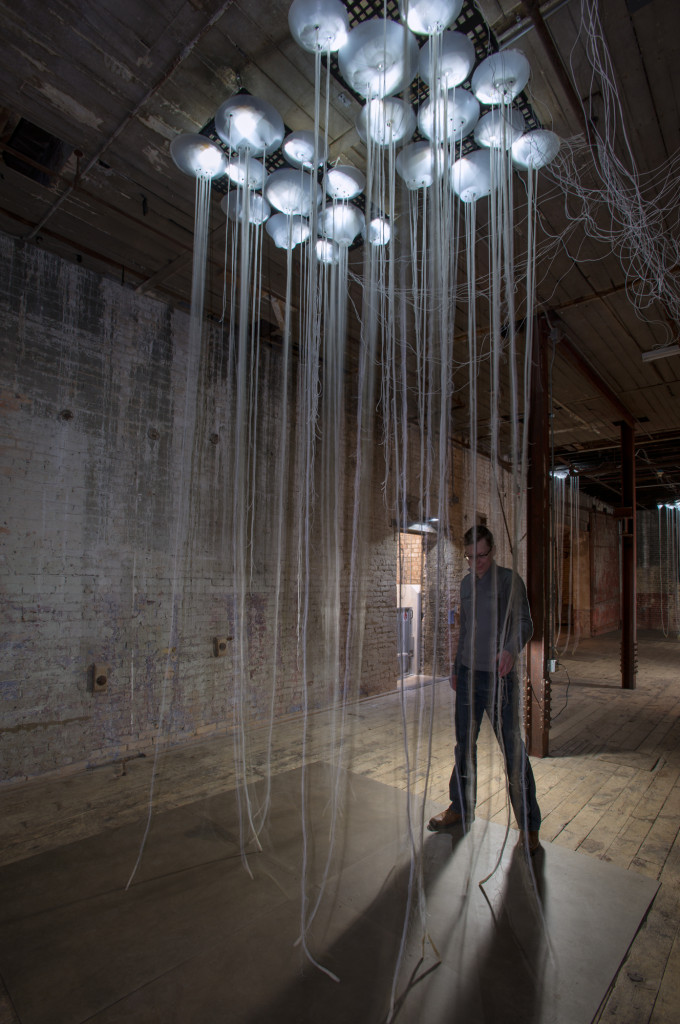
Alison Hiltner, Survival Tactics
“I’m aiming for something that straddles a line between cheesy simulation and an authentic approximation of life.”
Survival Tactics
Survival Tactics explores how recent scientific discoveries in plant communication further our growing knowledge of sentient behavior in the flora and fauna of our environment. This piece was inspired specifically by how the root systems of plants can “talk” to each other through high-frequency acoustic vibrations when under stress.
Modular groupings of synthetic root formations are scattered throughout the gallery; larger roots and smaller fibrous formations cascade from conical crystalline protrusions. The larger root strands have intelligence. They are programmed to search for and react to surfaces and each other, resulting in a timed waltz set to their own vibrations and the interference of the approaching interlopers, the audience. The movement of the roots implies a system of communication similar to an egalitarian insect colony—differentiating function without the reproductive caste system.
Survival Tactics is an exchange between the audience and this root colony that has insinuated itself into the gallery’s ecosystem. The roots search, struggle, and collect, actively analyzing their surroundings. In essence, this piece explores how networked organisms both alter and adapt to their circumstances and how change may come from outside that network. Survival Tactics facilitates an interaction that questions the difference between investment and interference. Does the act of disentangling the roots as they wrap around one another, or moving them as they search the floor’s surface, create a better or worse situation for them? By pondering the mechanisms species use to adapt and survive in rapidly changing circumstances, we may become more aware of the role we play in our natural world.
Carnal and mechanical…
Susannah Schouweiler
A growing body of research suggests plant life has an active, networked intelligence, a rudimentary awareness of self and others that translates into behavior that, upon study, looks downright social. According to an article in The Scientist in January 2014, plants seem to recognize the difference between “kin” and foe, sharing information about all manner of threats by way of chemical and ultrasonic communication. Plants “talk” by releasing volatile compounds into the air and through the soil. “They eavesdrop on hints of their neighbors’ distress through their root systems”: the unharmed plants “hearing” that cue respond as if distressed themselves, repeating the warning—of drought conditions, pathogens, herbivores, or insect infestations—so the alert ultimately spreads to plants far beyond those immediately affected.
Installation artist Alison Hiltner is fascinated by the questions raised by this emerging science of floral agency and communication. “I want to understand in precisely what ways these supposedly ‘lower life forms’ are sentient,” she says. “I want to see it in action. This project has been an experiment, a way of beginning to answer my questions by making something tangible that simulates those modes of communication.”
The sculptural installation Survival Tactics is at once carnal and mechanical. Maggot-white, translucent “root systems” made of medical-grade silicone dangle in bunches from sixty-some gently lit pods mounted high on the ceiling. Wires snake through the main “root” filaments, which are fringed in hair-like tendrils and culminate in wrinkly, delicate stubs of latex that house small vibration motors near the floor.
Once activated, the mechanically animated root systems quiver and jerk and buzz. The movement is twisty, searching, and apparently inquisitive. Faced with an obstruction, the root tendrils seem to trace its presence, tentatively but persistently, as if investigating by feel. The silicone is luminous, soft like new skin under a scab. Add the roots’ appearance of intention—the persuasive semblance of a desire to touch back, to engage—and the effect of standing among them is disarming, uncanny. It’s repulsive and alluring in equal measure.
Hiltner didn’t want her “roots” to get lost against the imposing backdrop of the gallery’s distinct postindustrial character. “To be effective, the installation had to be able to stand up to the architecture of The Soap Factory, to seem at home in the space but not overpowered by it. And to do that, the scale needed to be big. I want this to feel like an infestation.”
“All my work has a sci-fi twist,” she laughs. “It tends toward the dramatic. I love the unsettling effect of bringing what’s usually hidden into the light. I’m aiming for something that straddles a line between cheesy simulation and an authentic approximation of life.” Hiltner continues: “I want a viewer to understand there’s something going on beyond just unthinking chaos”—and, in doing so, to feel a renewed interest in discovering this world, all around us, we only think we know.
Artist Statement
I view myself as an archaeologist of science fiction, exploring the media landscape of films, television, and video games and intertwining these themes with current scientific inquiry. I appropriate and stitch together visual cues to create tableaus, interspersed with elements such as the terrain of ocean and rainforest floors, interiors of the human body, or nebulous arrays of stardust. The resulting sculptural environments, made with various mediums and processes, confront the viewer with something alien yet undeniably familiar.
Since childhood I have found inspiration in the environments displayed in history and science museums, encapsulated moments in time inviting viewers to observe what once was and consider the lessons these histories can teach us moving forward. Each piece is a vignette of research in process, an artifact tenuously balanced between what is real and what is imagined. This interplay of fact and fiction emphasizes how our existence can be a constant reminder that “science is magic that works” (Kurt Vonnegut).
The central driving concept in my work is a fascination with how science fiction cinema influences our current understanding of scientific research and how that filter of understanding will affect future technological advancement. By maintaining a sense of wonder, humor, and a touch of the absurd, the conceptual anchor of these pieces is earnest manipulation, driven by a curiosity about the stranger aspects of our existence.
Alison Hiltner
b. Wichita, Kansas
lives in Minneapolis
mentor: Diane Willow
Alison Hiltner currently lives and works in Minneapolis, MN. She received a BFA from the University of Kansas and a MFA from the University of Minnesota. Hiltner’s credits include solo exhibitions at Spike Gallery in New York, the Museum of Surgical Sciences in Chicago and Heineman Myers Contemporary Art in Washington DC. In 2004 Alison was an artist in residence at Sculpture Space and received a Minnesota State Arts Board Artist Initiative Grant in 2007 and 2011, MRAC/McKnight Foundation Next Step Grant and was named one of the 2011/12 Jerome Foundation Fellows. Hiltner has exhibited in numerous group exhibitions on the east coast and the Midwest including the Minnesota Biennial: 3D II at the Minnesota Museum of American Art and recently at the Evanston Art Center in Chicago.